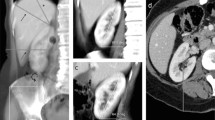Abstract
Purpose
To evaluate the anatomical changes in kidney orientation in prone position with use of horizontal or vertical bolster alignment.
Methods
Patients having renal stone(s) on ultrasonogram or X-ray underwent split bolus computed-tomo-urography (CTU) in prone position with horizontal and vertical bolster positions. CTUs were read by a single radiologist to quantify the cranio-caudal, antero-posterior, side to side and rotational movements of kidneys as relevant to prone percutaneous nephrolithotomy.
Results
19 adult patients with 38 renal units and mean basal metabolic index of 25.6 kg/m2 underwent CTU. Greater inferior displacement of both kidneys was seen with horizontal bolsters as compared to vertical bolsters. The right upper calyceal-diaphragm distance was 2.1 ± 1.5 cm and the lower calyceal-diaphragm distance was 2.0 ± 1.6 cm greater with the horizontal bolsters (p < 0.01). Similarly, the displacement on the left side was 1.5 ± 0.8 cm and 1.4 ± 0.8 cm, respectively (p < 0.01). Horizontal bolsters also result in significantly longer calyceal-skin distance at both poles of both kidneys [right upper: 0.4 ± 0.5 cm (p < 0.01), right lower: 0.8 ± 0.7 cm (p < 0.01), left upper: 0.4 ± 0.6 cm (p = 0.02), left lower: 0.8 ± 1.1 cm (p < 0.01)] and wider erector spinae-mid posterior calyceal-colon angle (124.8 v/s 110.0 on the right and 96.2 v/s 85.7 on the left) (p < 0.01).
Conclusion
Horizontal bolsters provide significantly more caudal displacement of the kidneys; the right kidney being displaced more as compared to the left. However, there is also an increase in the skin-calyceal distance with horizontal as compared to the vertical bolsters. These assessments may help the surgeons decide optimal bolster position individualized to the patient.


Similar content being viewed by others
References
EAU Guidelines. Edn. presented at the EAU Annual Congress Amsterdam 2020. ISBN 978-94-92671-07-3.https://uroweb.org/guideline/urolithiasis/#3
Duty B, Waingankar N, Okhunov Z, Ben Levi E, Smith A, Okeke Z (2012) Anatomical variation between the prone, supine, and supine oblique positions on computed tomography: implications for percutaneous nephrolithotomy access. Urology 79(1):67–71. https://doi.org/10.1016/j.urology.2011.06.019
Azhar RA, Szymanski KM, Lemercier E, Valenti D, Andonian S, Anidjar M (2011) Visceral organ-to-percutaneous tract distance is shorter when patients are placed in the prone position on bolsters compared with the supine position. J Endourol 25(4):687–690. https://doi.org/10.1089/end.2010.0547
Sagalovich D, Besa C, Tran TY, Thummar H, Le Grand B, Taouli B et al (2017) Prone percutaneous nephrolithotomy: Does bolster orientation matter? Urology 108:46–51. https://doi.org/10.1016/j.urology.2017.07.005
Renard-Penna R, Rocher L, Roy C, André M, Bellin MF, Boulay I, Eiss D, Girouin N, Grenier N, Hélénon O, Lapray JF, Lefèvre A, Matillon X, Ménager JM, Millet I, Ronze S, Sanzalone T, Tourniaire J, Brunelle S, Rouvière O, French society of genitourinary imaging consensus group (2020) Imaging protocols for CT urography: results of a consensus conference from the French society of genitourinary imaging. Eur Radiol 30(3):1387–1396. https://doi.org/10.1007/s00330-019-06529-6
Shaish H, Newhouse JH (2017) Split-bolus CT urogram: Is less more? Abdom Radiol (NY) 42(8):2119–2126. https://doi.org/10.1007/s00261-017-1098-3
Ray AA, Chung DG, Honey RJ (2009) Percutaneous nephrolithotomy in the prone and prone-flexed positions: anatomic considerations. J Endourol 23(10):1607–1614. https://doi.org/10.1089/end.2009.0294
Marchini GS, Berto FC, Vicentini FC, Shan CJ, Srougi M, Mazzucchi E (2015) Preoperative planning with noncontrast computed tomography in the prone and supine position for percutaneous nephrolithotomy: a practical overview. J Endourol 29(1):6–12. https://doi.org/10.1089/end.2014.0299
Patel RM, Okhunov Z, Clayman RV, Landman J (2017) Prone versus supine percutaneous nephrolithotomy: What is your position? CurrUrol Rep 18(4):26. https://doi.org/10.1007/s11934-017-0676-9
Author information
Authors and Affiliations
Corresponding author
Additional information
Publisher's Note
Springer Nature remains neutral with regard to jurisdictional claims in published maps and institutional affiliations.
Rights and permissions
About this article
Cite this article
Singh, P., Nayyar, R., Bagga, B. et al. Effects of horizontal versus vertical bolster alignment on anatomical orientation of kidney as applied to prone percutaneous nephrolithotomy. World J Urol 39, 4471–4476 (2021). https://doi.org/10.1007/s00345-021-03728-z
Received:
Accepted:
Published:
Issue Date:
DOI: https://doi.org/10.1007/s00345-021-03728-z




